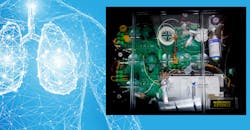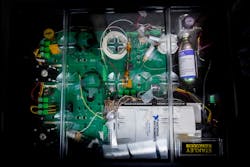Portable Breath Analyzer Spots Deadly Lung Disease Faster Than Doctors
A shoebox-sized, portable breath monitor developed at the University of Michigan quickly and accurately detect acute respiratory distress syndrome (ARDS), an often-deadly disease that causes fluid to leak into the lungs. ARDS is a severe form of lung inflammation caused by pneumonia, sepsis, trauma, aspiration, or a combination of these conditions. It carries a high mortality rate. In the U.S., 200,000 cases are diagnosed annually, resulting in 74,000 deaths.
Many who survive are left with poor lung function and have great difficulty returning to routine daily activities. There is no cure for ARDS, and mechanical ventilation in an intensive care unit is usually required to support the patient until the lung heals. Detecting it early improves patients’ outcomes.
Until now, doctors had to rely heavily on their own judgment and time-consuming tests. The Michigan biomedical engineers say their device could lead to diagnostic instruments that improve ARDS survival rates and lower the cost of care.
The hardware inside the protective covering of a breath monitor developed by the University of Michigan that can quickly and accurately detect acute respiratory distress syndrome (ARDS). (Courtesy Robert Coelius/Michigan Engineering, Communications and Marketing)
The device, a gas chromatographer, diagnoses ARDS with nearly 90% accuracy in as little as 30 minutes. In addition, its speed and cost-effectiveness let it serve as a real-time monitor for patients, helping to focus and adjust treatments in progress.
“The most commonly used ARDS prediction tools now are only correct about 18% of the time,” says Xudong (Sherman) Fan, a UM professor of biomedical engineering. “With our machine, we can detect the onset and improvement of the condition before traditional changes in X-rays and blood testing would occur.”
UM’s device samples a patient’s breath through tubing connected to the exhalation port of a mechanical ventilator. It analyzes nearly 100 volatile organic compounds, biomarkers that denote ARDS and also determine how far along the disease is. The device can also track how effective treatment is in curing it.
Currently, a doctor who suspects ARDS orders a chest X-ray and blood tests. The first is expensive and exposes the patient to radiation, and the second is invasive. The combination can take hours to completely analyze, and results represent one snapshot in time. To know if the condition is improving or worsening, they must be repeated.
Results from the portable breath analyzer come in the form of a graph. (Courtesy: Robert Coelius/Michigan Engineering, Communications and Marketing)
“Our ability to improve outcomes with ARDS has been basically halted by the lack of ways to rapidly and accurately diagnose the disease early as well as track its progress,” says Kevin Ward, UM professor of emergency medicine and biomedical engineering. “But by analyzing exhaled breath, we’ve solved both problems and opened up significant opportunities that let us treat ARDS earlier and to develop a host of precision medicine therapies.”
The research team sees ARDS as the first of many conditions that could be better identified and tracked with this new technology. “The technology should also be extremely useful in detecting and following the course of many other diseases such as pneumonia, sepsis, asthma, and others associated with either lung or systemic blood inflammation,” Ward says.
The university is pursuing patent protection for the intellectual property and is seeking commercialization partners to help bring the technology to market.



